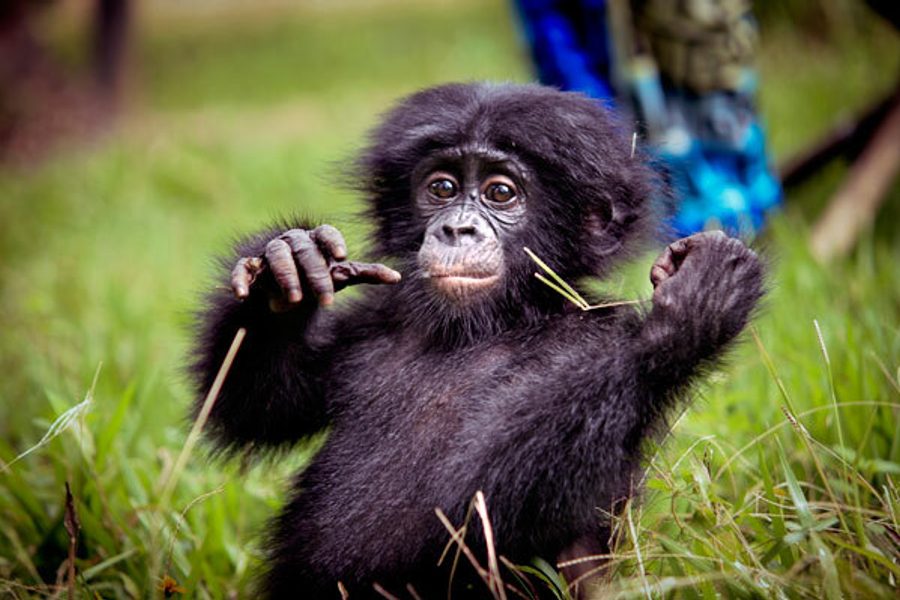A Kinder, Gentler, Bisexual Great Ape
Dominique Morel’s quest to save the bonobo.
Alexandra Markowski

When Dominique Morel arrived in the Democratic Republic of Congo in 1997, she had no background in animal protection. Nor had she heard of bonobos, one of two great ape species most closely related to humans. But after her first visit to the bonobo sanctuary founded by the Congolese nonprofit Amis de Bonobos du Congo (ABC), Morel fell in love with the peaceful matriarchal creatures. Although they share 98.7 percent of humans’ DNA, bonobos have created a society – unlike that of chimps and people – without violence, in which sex is a form of mediation.
Morel volunteered weekends as a surrogate mother for the young animals and began helping with the translation of the ABC’s newsletter. She has steadily dedicated more of her life to bonobos, securing grants and other funding for Lola Ya Bonobo, the only bonobo sanctuary in the world. Caretakers there protect around 60 bonobos and prepare the animals for release back into the wild.
Bonobos are one of the planet’s most endangered species; scientists estimate 5,000 to 15,000 bonobos remain. They can be found only in the Congo, where they are thought to have evolved in relative isolation south and east of the Congo River, as chimpanzees evolved north of the river in Uganda and the Central African Republic.
Morel, who is French, is currently based in Islamabad, where she works for Catholic Relief Services, though she still serves as vice president of ABC and is president of the American chapter of the organization, Friends of Bonobos.
How did the evolutionary split between chimpanzees and bonobos affect their development?
The theory goes that south of the Congo River, the bonobo species was the only tree-dwelling, fruit-eating species that remained. Without competition for food, the bonobos remained in groups and became more tolerant. Meanwhile, north of the river, the chimpanzees were competing with gorillas for the same nourishment. So they formed smaller parties and had to forage individually and away from the other groups. Naturally, the chimps didn’t develop the same socially cooperative behaviors as the bonobos.
Why are so few bonobos left?
Researchers started to work in the Congo in the ’30s, and by the ’70s, civil war made it very difficult to track and research bonobos. Twenty years ago, scientists working in the wild estimated that about 100,000 bonobos were left, but this was an estimate. Because bonobos tend to come together when they are afraid, during the war bushmeat hunters were likely to encounter and kill entire groups of bonobos.
How do the social structures of bonobos and chimpanzees differ?
Chimps have one dominant male ruling a group. In bonobo groups, females are the dominant individuals. They keep the peace. We had one incident when a young adult male bonobo, Tatango, kept provoking an older male, Max, a very peaceful twenty-something adult. Every time Tatango would charge Max, confusion and shouting ensued. After several days of this, the five young adult females joined ranks and attacked the troublemakers. They attacked both males, as if to teach them both a lesson, and it was enough to bring back peace in the group.
Many studies comparing bonobos and chimpanzees refer to the element of tolerance. Tolerance is what allows bonobos to be more cooperative than chimpanzees. There’s no tension; everybody can collaborate with each other.
Chimps are known to kill members of other chimp groups. There can be a lot of intimidation and aggression of younger males by the alpha males. Bonobo groups are much more peaceful, and while there is sometimes tension among individuals, there is little violence.
How can the difference between bonobos and chimps help us understand ourselves?
These differences give another perspective to our evolutionary path and understanding of what it is that makes us human. For a long time, we only thought chimps could help us understand human evolution. Many people still don’t know that bonobos and chimps are equally our two closest relatives.
It is certainly not a coincidence that the image of our ancestors emphasizes the aggressive and violent nature of humans – “brutish and short” – while more peaceful, altruistic, empathetic human characteristics are sometimes considered a result of evolution or even a “social varnish” over our “true nature.” This is a misconception.
Understanding that we are as close genetically to bonobos as to chimps suggests that pacifism, playfulness, empathy, and collaboration may also be part of human nature and not merely cultural or learned behaviors.
What is it with bonobos and sex?
Sexual activity is the key factor in appeasing tension in bonobo groups. Bonobos engage in sexual activity – most often just sexual contact – every time they are stressed, both when they are excited and when they are upset or jealous.
It is not unusual for young bonobos to throw tantrums. Usually, another bonobo comes to embrace and rub genitals with the crying bonobo until he or she has calmed down.
And then there’s the “bonobo handshake.” When we introduce a new bonobo into a group, every one of the bonobos will come and offer themselves for a quick sexual contact with the newcomer.
Why should we save bonobos from extinction?
The most important reason to save bonobos is that they are one of our closest relatives, but probably one of the least understood of the Great Apes. If we are trying to understand our evolution, we need to understand bonobos.
Understanding more of what is unique about bonobos – their sexual tension resolutions, peaceful nature and female leadership – could help us learn why humans are who we are. How can we be more like bonobos and less like chimpanzees? How can we be more peaceful? Understanding bonobos can help us answer these questions.
What does Friends of Bonobos do to ensure the species’ survival?
We have a three-fold strategy. The first part is the sanctuary, Lola Ya Bonobos. It is illegal to hunt bonobos, illegal to trade bonobos, and illegal to eat bonobo meat. But for the [Congolese]Ministry of Environment, it’s very difficult to confiscate bonobos and enforce these laws unless they have a place to put them. … Bonobos are psychologically fragile, they can’t live in zoos. They need a lot of affection and a lot of contact to survive.
The sanctuary in itself is not enough. We also need to prevent the bushmeat trade. We target urban environments, because the residents of the urban areas tend to be the consumers, both of bonobos as pets and bushmeat. We try to encourage Congolose people to appreciate bonobos for what they are. It’s working well, as people who have learned that it is illegal to eat, kill or keep bonobos bring the animals to the sanctuary.
How does education play a role in bonobo preservation?
I remember vividly the first day I saw bonobos in person. One of the bonobos, a young female named Oshwe, approached my husband, took his hand and pulled him toward one side of the garden. When they arrived near a tree covered in small fruit, she climbed all over him and onto his shoulders and his head, until she could reach the branches covered in fruit, and then started to eat. After a while, she climbed down the same way, took his hand again and led him back to the group.
I could tell hundreds of similar stories of bonobo behaviors that seem so human – demonstrating empathy to one another, hugging each other, infants looking to their surrogate mothers to cuddle, youngsters having a tantrum or playing tricks on one another, or adults mourning a dead bonobo.
We use these human-like behaviors in our efforts to protect bonobos in the Congo. It is very difficult to see bonobos in the wild when they move around on treetops. The hunters who kill them to sell as bushmeat have probably never seen a live bonobo, and it’s even less likely the merchants and the people who purchase the meat to eat would have seen one. By making the orphan bonobos accessible for direct observation by so many Congolese people, Lola Ya Bonobo Sanctuary, and now the release site at Ekolo Ya Bonobo, play a key role in conservation education. Once people have seen bonobos in person, almost everyone is adamant that they’ll never eat bonobo meat anymore – it would be like eating one’s cousins or ancestors.





